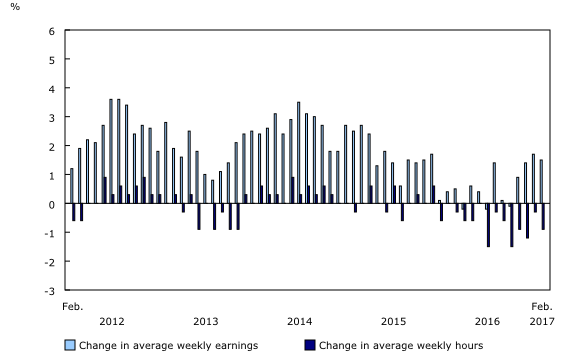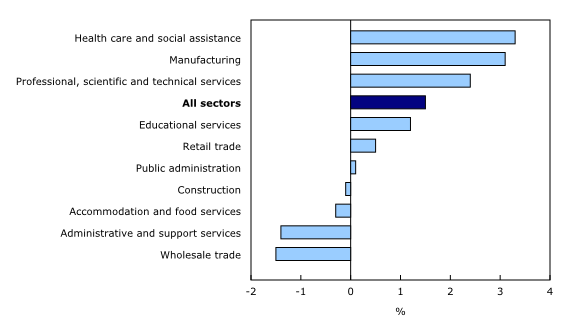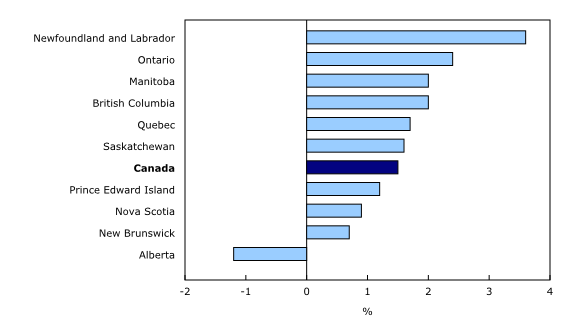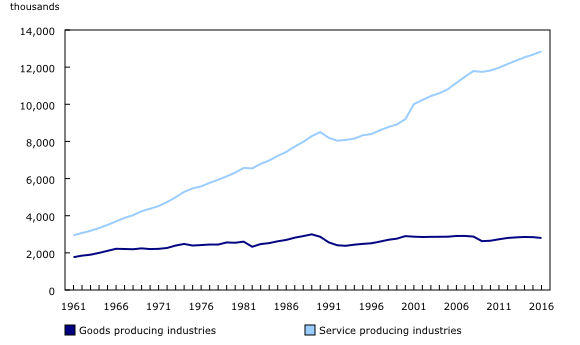Payroll employment, earnings and hours, February 2017
Archived Content
Information identified as archived is provided for reference, research or recordkeeping purposes. It is not subject to the Government of Canada Web Standards and has not been altered or updated since it was archived. Please "contact us" to request a format other than those available.
Released: 2017-04-27
$967.59
February 2017
1.5% 
(12-month change)
$1,041.88
February 2017
3.6% 
(12-month change)
$822.80
February 2017
1.2% 
(12-month change)
$859.48
February 2017
0.9% 
(12-month change)
$872.89
February 2017
0.7% 
(12-month change)
$894.14
February 2017
1.7% 
(12-month change)
$987.72
February 2017
2.4% 
(12-month change)
$907.02
February 2017
2.0% 
(12-month change)
$1,003.64
February 2017
1.6% 
(12-month change)
$1,108.40
February 2017
-1.2% 
(12-month change)
$931.22
February 2017
2.0% 
(12-month change)
$1,105.04
February 2017
5.2% 
(12-month change)
$1,392.32
February 2017
-3.2% 
(12-month change)
$1,320.47
February 2017
4.4% 
(12-month change)
Average weekly earnings of non-farm payroll employees were $968 in February, little changed from January and up 1.5% from 12 months earlier.
In general, changes in weekly earnings reflect a number of factors, including wage growth; changes in the composition of employment by industry, occupation and level of job experience; and average hours worked per week.
Non-farm payroll employees worked an average of 32.6 hours per week in February, down slightly from 32.7 hours in January and less than the 32.9 hours observed 12 months earlier.
Average weekly earnings by sector
Compared with February 2016, average weekly earnings rose in 3 of the 10 largest industrial sectors: health care and social assistance; manufacturing; and professional, scientific and technical services. Earnings were little changed in the remaining large sectors.
Average weekly earnings in health care and social assistance increased 3.3% to $893. Earnings were up across all subsectors, with the largest increase in hospitals.
In manufacturing, average weekly earnings rose 3.1% to $1,116. Earnings growth was spread across transportation equipment, wood product and chemical manufacturing. Earnings in manufacturing increased in most provinces, and employment also increased notably in Quebec, Ontario and British Columbia. Earnings in manufacturing have been on an upward trend since the fall of 2016.
In professional, scientific and technical services, weekly earnings grew 2.4% to $1,333. Notable increases were observed in Ontario and Nova Scotia.
Average weekly earnings by province
In the 12 months to February, average weekly earnings of non-farm payroll employees rose in 7 provinces, led by Newfoundland and Labrador. Earnings were down in Alberta and little changed in Nova Scotia and New Brunswick.
Average weekly earnings in Newfoundland and Labrador increased 3.6% to $1,042, driven by gains in construction and educational services. The increase was also due in part to earnings in this province having been at a relatively low point in February 2016.
In Ontario, average weekly earnings grew 2.4% to $988. Earnings growth was spread across several sectors, especially professional, scientific and technical services, manufacturing, and health care and social assistance.
Average weekly earnings in Manitoba rose 2.0% to $907, with notable gains in health care and social assistance. Earnings in the province have trended upward since October 2016.
Average weekly earnings in British Columbia were up 2.0% to $931. Finance and insurance, manufacturing and construction were the largest contributors to growth.
In Quebec, average weekly earnings grew 1.7% to $894. Earnings growth was primarily driven by gains in manufacturing and health care and social assistance. Earnings in the province have been on an upward trend since the summer of 2016.
Average weekly earnings in Saskatchewan rose 1.6% to $1,004. Earnings in the province were boosted by educational services and construction.
In Prince Edward Island, earnings were up 1.2% to $823, with notable gains in health care and social assistance, and in manufacturing.
On the other hand, average weekly earnings in Alberta fell 1.2% to $1,108. The decline was driven by decreases in construction and wholesale trade. However, the downward trend in the province that began in 2015 has lessened since the second half of 2016.
Non-farm payroll employment by sector
The total number of non-farm payroll employees rose by 64,500 (+0.4%) from January. The number of payroll jobs grew the most in retail trade and educational services. At the same time, there were fewer payroll employees working in administrative and support services.
Compared with February 2016, the number of non-farm payroll employees was up 305,100 (+1.9%). Increases were observed in most of the largest industrial sectors, led by health care and social assistance (+47,400 or +2.6%), accommodation and food services (+31,900 or +2.5%), construction (+26,200 or +2.7%) and professional, scientific and technical services (+25,600 or +3.0%). At the same time, there was little change in the number of employees in wholesale trade.
Recent labour market developments
In the 12 months to February, the pace of employment growth was similar in both of Statistics Canada's monthly surveys with data on employment: the Survey of Employment, Payrolls and Hours (SEPH) and the Labour Force Survey (LFS).
During this period, both surveys showed employment gains in Ontario, Quebec, British Columbia as well as New Brunswick. Specifically in New Brunswick, the number of payroll employees in SEPH showed growth of 1.8%, comparable to the national average (+1.9%) although earnings were little changed. At the same time, the LFS showed the unemployment rate for the province declined 0.9 percentage points to 8.9%.

In celebration of the country's 150th birthday, Statistics Canada is presenting snapshots from our rich statistical history.
Employment shift from goods producing to service producing industries
In the early 1900s, Canada's economy was based predominantly on natural resources and agriculture. Combined with existing industries in logging and hydroelectricity, new industries such as metal and mineral exploration emerged at the start of that century to boost the natural resource economy.
At the same time, the growth in agricultural production in central Canada increased the demand for machinery, leading to growth in the manufacturing industry. Canada began shifting away from an agricultural economy in the early decades of the 20th century, partially due to greater urbanization and industrialization. The First World War also contributed to growth in the manufacturing industry, in the form of a demand for ships, weapons and ammunition.
After the Great Depression, Canada's economy was driven by the Second World War. As men left for war, the labour force participation of women rose significantly in manufacturing, as well as in trade and finance, contributing to an increase in employment in the service producing industries.
In the late 1950s, Canada's economy shifted from a predominantly goods-based economy to that of a service-based economy. Since that time, employment in service producing industries has increased to a greater extent than has employment in goods producing industries. For example, in 1961, there were 1.8 million payroll employees working in goods producing industries, or 37% of all employees. By 2016, this number had increased to 2.8 million, but the proportion had fallen to 18%. By contrast, in the service producing industries, there were 2.9 million payroll employees in 1961, or 63% of all employees. By 2016, payroll employees had increased in both number (12.8 million) and percentage (82%) of the workforce.
Sources: Guide to the Survey of Employment Payrolls and Hours (72-203-G), and "One hundred years of labour force" in Canadian Social Trends (11-008-X).
Note to readers
The Survey of Employment, Payrolls and Hours (SEPH) is produced by a combination of a census of approximately one million payroll deductions provided by the Canada Revenue Agency, and the Business Payrolls Survey, which collects data from a sample of 15,000 establishments. Federal, provincial and territorial public administration data are collected from various administrative records provided by these levels of government. The key objective of the SEPH is to provide a monthly portrait of the level of earnings and the number of jobs and hours worked by detailed industry at the national, provincial and territorial level.
Estimates of average weekly earnings and hours worked are based on a sample and are therefore subject to sampling variability. This analysis focuses on differences between estimates that are statistically significant at the 68% confidence level. Payroll employment estimates are based on a census of administrative data and are not subject to sampling variability.
Statistics Canada also produces employment estimates from its Labour Force Survey (LFS). The LFS is a monthly household survey, the main objective of which is to divide the working-age population into three mutually exclusive groups: the employed (including the self-employed), the unemployed, and those not in the labour force. This survey is the official source for the unemployment rate and collects data on the socio-demographic characteristics of all those in the labour market.
As a result of conceptual and methodological differences, estimates of changes from the SEPH and LFS differ from time to time. However, the trends in the data are quite similar. To better understand the conceptual differences between employment measures from the LFS and SEPH, refer to section 8 of the Guide to the Survey of Employment, Payrolls and Hours (72-203-G).
Unless otherwise stated, this release presents seasonally adjusted data, which facilitate comparisons by removing the effects of seasonal variations. For more information on seasonal adjustment, see Seasonally adjusted data – Frequently asked questions.
Non-farm payroll employment data are for all hourly and salaried employees, as well as for the "other employees" category, which includes piece-rate and commission-only employees.
Unless otherwise specified, average weekly hours data are for hourly and salaried employees only and exclude businesses that could not be classified to a North American Industry Classification System (NAICS) code.
All earnings data include overtime pay and exclude businesses that could not be classified to a NAICS code. Earnings data are based on gross taxable payroll before source deductions. Average weekly earnings are derived by dividing total weekly earnings by the number of employees.
With each release, data for the current reference month are subject to revision. Data have been revised for the previous month. Users are encouraged to request and use the most up-to-date data for each month.
Real-time CANSIM tables
Real-time CANSIM tables 281-8023, 281-8026, 281-8047 and 281-8063 will be updated on May 8. For more information, consult the document Real-time CANSIM tables.
Next release
Data on payroll employment, earnings and hours for March will be released on May 25.
Products
A summary table is also available.
Job Vacancy Statistics (5202) from the Survey of Employment, Payrolls and Hours for January are now available in CANSIM.
More information about the concepts and use of the Survey of Employment, Payrolls and Hours and Job Vacancy Statistics is available in the Guide to the Survey of Employment, Payrolls and Hours (72-203-G).
Contact information
For more information, contact us (toll-free 1-800-263-1136; 514-283-8300; STATCAN.infostats-infostats.STATCAN@canada.ca).
To enquire about the concepts, methods or data quality of this release, contact Dylan Saunders (613-762-6972; dylan.saunders@canada.ca) or Client Services (toll-free: 1-866-873-8788; statcan.labour-travail.statcan@canada.ca), Labour Statistics Division.
- Date modified:





